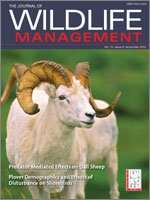The combination of ecological site descriptions and state-and-transition models (STMs) describes potential vegetation, plant composition, and plant community dynamics and thus can be used to classify and understand dynamics of wildlife habitats across landscapes or home ranges. Numerous studies have evaluated effects of plant community dynamics on diversity and abundance of wildlife populations, but we could find no studies that examined changes in wildlife populations with respect to STMs. We compared abundance of grasshopper sparrows (Ammodramus savannarum) across 5 community phases representing 2 different ecological states in the Columbia Basin, Oregon, USA, to evaluate utility of STMs for understanding and predicting potential changes in habitat use by wildlife species. We measured grasshopper sparrow abundance in 165 100-m fixed-radius point counts distributed across 17 study plots within 5 plant community phases: native perennial grassland, sagebrush-steppe, depleted sagebrush-steppe, sagebrush-steppe with an annual grass understory, and annual grassland. We used a general estimating equation with a Poisson distribution to model relative abundance and estimate differences in this abundance index between linked pairs of community phases. Grasshopper sparrows showed clear differences in abundance among community phases and were most numerous in perennial grasslands and least abundant in depleted sagebrush and sagebrush annual grass community phases. As a management tool, STM provides information that predicts the direct and indirect cumulative impacts of various management actions on vegetation composition and structure (and thus habitat). Ecological site descriptions and STMs enable land managers and scientists to assess potential and current wildlife habitat suitability and to predict potential response of wildlife populations to vegetation dynamics based on the ecological potential of the site.
How to translate text using browser tools
1 November 2010
State-and-Transition Models for Assessing Grasshopper Sparrow Habitat Use
Aaron L. Holmes,
Richard F. Miller
ACCESS THE FULL ARTICLE
It is not available for individual sale.
This article is only available to subscribers.
It is not available for individual sale.
It is not available for individual sale.

Journal of Wildlife Management
Vol. 74 • No. 8
November 2010
Vol. 74 • No. 8
November 2010
Ammodramus savannarum
Artemisia tridentata
Bromus tectorum
ecological site
Grasshopper Sparrow
grassland
sagebrush-steppe




